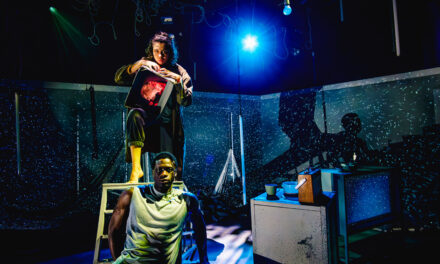The semi-permeable membrane to pop cultural recognition on a universal scale is one which is easier for personalities of a certain cast to pass through: the lightly entertaining, the inoffensively presentable, the sportingly precocious, the familiarly surnamed. Stephen Hawking, a theoretical physicist, who, after being diagnosed with motor neurone disease at the age of 21, gradually came to be reliant on a wheelchair for mobility and, following a bout of pneumonia in 1985, a voice synthesiser for speech, was none of these things.
Manchester’s Science and Industry Museum’s new boutique exhibition, curated by Juan-Andres Leon, attempts to unpick the tangle of these contrasting identities, as a physicist, a person living with a neurodegenerative disease, and – almost eclipsing both – a popular science communicator, only to find that the strings of each persona remain entangled, despite the distance of time. In taking on this methodology, it also sheds light on how his singularity, and perhaps, too, his awareness of how his difference marked him out, led to his star going supernova.
 Drawing upon the contents of his office in the Department for Applied Mathematics and Theoretical Physics at Cambridge University, which the museum acquired in 2021, it works out his biography, deriving it from the selected ephemera of his working life. Not numerous in their quantity, it is nonetheless the quality of the artefacts chosen that equate to something like the sum of his existence.
Drawing upon the contents of his office in the Department for Applied Mathematics and Theoretical Physics at Cambridge University, which the museum acquired in 2021, it works out his biography, deriving it from the selected ephemera of his working life. Not numerous in their quantity, it is nonetheless the quality of the artefacts chosen that equate to something like the sum of his existence.
One of the best exemplars of how even the smallest of exhibits can be dense with the charge of Hawking’s life story is his original voice synthesiser case, complete with a personalised miniature license plate reading ‘Stephen’. Originally a post-tracheotomy necessity, Hawking came to recognise its potential virtues. So much so, in fact, that he eventually considered this Americanised voice, developed for use in automated answering services, as his own, and declined all subsequent offers to ‘humanise’ it in line with the technology’s advance. Perhaps this refusal evolved from an emotional attachment to the device, or maybe a disinclination to soften the blow of his disability out of deference to others’ sensibilities. Whatever his motives, it is arguable that its distinctive Speak & Spell robotic cadences came, over the decades, to be part of what an influencer might call his ‘brand’. Hawking, a signatory on the Charter for the Third Millennium on Disability, owned it.
More than this, the limitations that the synthesiser imposed on speech production – initially a top speed of around 20 words per minute – necessitated concision in what Hawking said, and memorability in the way that he said it. The titles of his theses, Black Hole Explosions for example, read more like tabloid headlines or pomp rock song titles than the more typically arid convolutions of academic papers.
There was something, too, of the conceptual artist in his approach to communicating complexity across the widest possible bandwidth. His Reception For Time Travellers, in which the invitations were sent out only after Hawking hosted the guest-free party on June 28, 2009, leaves a lasting impression – if hardly a conclusive proof – of the organiser’s certainty in its theoretical impossibility. Alongside such telegenic happenings, Hawking’s well-publicised penchant for public wagers seems further evidence of his attraction to showmanship. Not shy of controversy, sometimes to the irritation of others – so that Peter Higgs (of Higgs boson fame) wearily observed that his “celebrity status gives him instant credibility that others do not have” – he was willing to concede when, as was the case with the boson, the evidence ultimately proved him wrong. 
All things considered, the specimens behind the glass, ranging from spectacles modified with an in-built infrared sensor to a cast baseball jacket from The Simpsons, describe Hawking with something approaching the elegance of the equation, describing the radiation he theorised, inscribed on his tombstone. It makes for a brief history of his times, and, by extension, of ours.
Stephen Hawking at Work is at the Science and Industry Museum, Manchester until January 2024. For more information, click here.

Permobil model F3 Corpus wheelchair © The Board of Trustees of the Science Museum
Main image: Professor Stephen Hawking in his office at the University of Cambridge © Sarah Lee
Images courtesy of the Science and Industry Museum, Manchester








